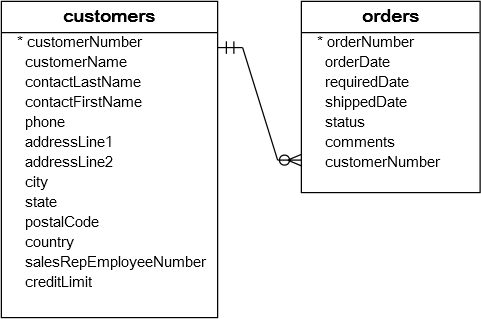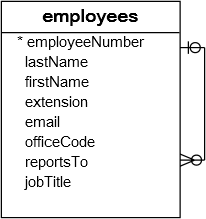MySQL Foreign Key
2017-01-20 21:49
218 查看
ntroduction to MySQL foreign key
A foreign key is a field in a table that matches another field of another table. A foreign key places constraints on data in the related tables, which enables MySQL to maintain referential integrity.Let’s take a look at the following database diagram in the sample database.

We have two tables:
customersand
orders.Each customer has zero or more orders and each order belongs to only one customer. The relationship between
customerstable and
orderstable is one-to-many, and it is established by a foreign key in the
orderstable specified by the
customerNumberfield. The
customerNumberfield in the
orderstable relates to the
customerNumberprimary key field in the
customerstable.
The
customerstable is called parent table or referenced table, and the
orderstable is known as child table or referencing table.
A foreign key can be a column or a set of columns. The columns in the child table often refer to the primary key columns in the parent table.
A table may have more than one foreign key, and each foreign key in the child table may refer to a different parent table.
A row in the child table must contain values that exist in the parent table e.g., each order record in the
orderstable must have a
customerNumberthat exists in the
customerstable. Multiple orders can refer to the same customer therefore, this relationship is called one (customer) to many (orders), or one-to-many.
Sometimes, the child and parent tables are the same. The foreign key refers back to the primary key of the table e.g., the following
employeestable:

The
reportTocolumn is a foreign key that refers to the
employeeNumbercolumn which is the primary key of the
employeestable to reflect the reporting structure between employees i.e., each employee reports to anther employee and an employee can have zero or more direct reports. We have a specific tutorial on the self-join to help you query data against this kind of table.
The
reportToforeign key is also known as recursive or self-referencing foreign key.
Foreign keys enforce referential integrity that helps you maintain the consistency and integrity of the data automatically. For example, you cannot create an order for a non-existent customer.
In addition, you can set up a cascade on delete action for the
customerNumberforeign key so that when you delete a customer in the
customerstable, all the orders associated with the customer are also deleted. This saves you time and efforts of using multiple DELETE statements or a DELETE JOIN statement.
The same as deletion, you can also define a cascade on update action for the
customerNumberforeign key to perform the cross-table update without using multiple UPDATE statements or an UPDATE JOIN statement.
In MySQL, the InnoDB storage engine supports foreign keys so that you must create InnoDB tables in order to use foreign key constraints.
Creating foreign keys for tables
MySQL creating foreign key syntax
The following syntax illustrates how to define a foreign key in a child table in CREATE TABLE statement.CONSTRAINT constraint_name
FOREIGN KEY foreign_key_name (columns)
REFERENCES parent_table(columns)
ON DELETE action
ON UPDATE action
| 1 2 3 4 5 | CONSTRAINT constraint_name FOREIGN KEY foreign_key_name (columns) REFERENCES parent_table(columns) ON DELETE action ON UPDATE action |
The
CONSTRAINTclause allows you to define constraint name for the foreign key constraint. If you omit it, MySQL will generate a name automatically.
The
FOREIGN KEYclause specifies the columns in the child table that refers to primary key columns in the parent table. You can put a foreign key name after
FOREIGN KEYclause or leave it to let MySQL create a name for you. Notice that MySQL automatically creates an index with the
foreign_key_namename.
The
REFERENCESclause specifies the parent table and its columns to which the columns in the child table refer. The number of columns in the child table and parent table specified in the
FOREIGN KEYand
REFERENCESmust be the same.
The
ON DELETEclause allows you to define what happens to the records in the child table when the records in the parent table are deleted. If you omit the
ON DELETEclause and delete a record in the parent table that has records in the child table refer to, MySQL will reject the deletion. In addition, MySQL also provides you with actions so that you can have other options such as ON DELETE CASCADE that ask MySQL to delete records in the child table that refers to a record in the parent table when the record in the parent table is deleted. If you don’t want the related records in the child table to be deleted, you use the
ON DELETE SET NULLaction instead. MySQL will set the foreign key column values in the child table to
NULLwhen the record in the parent table is deleted, with a condition that the foreign key column in the child table must accept
NULLvalues. Notice that if you use
ON DELETE NO ACTIONor
ON DELETE RESTRICTaction, MySQL will reject the deletion.
The
ON UPDATEclause enables you to specify what happens to the rows in the child table when rows in the parent table are updated. You can omit the
ON UPDATEclause to let MySQL reject any updates to the rows in the child table when the rows in the parent table are updated. The
ON UPDATE CASCADEaction allows you to perform a cross-table update, and the
ON UPDATE SET NULLaction resets the values in the rows in the child table to
NULLvalues when the rows in the parent table are updated. The
ON UPDATE NO ACTIONor
UPDATE RESTRICTactions reject any updates.
MySQL creating table foreign key example
The following example creates adbdemodatabase and two tables:
categoriesand
products.Each category has one or more products and each product belongs to only one category. The
cat_idfield in the
productstable is defined as a foreign key with
UPDATE ON CASCADEand
DELETE ON RESTRICTactions.
CREATE DATABASE IF NOT EXISTS dbdemo;
USE dbdemo;
CREATE TABLE categories(
cat_id int not null auto_increment primary key,
cat_name varchar(255) not null,
cat_description text
) ENGINE=InnoDB;
CREATE TABLE products(
prd_id int not null auto_increment primary key,
prd_name varchar(355) not null,
prd_price decimal,
cat_id int not null,
FOREIGN KEY fk_cat(cat_id)
REFERENCES categories(cat_id)
ON UPDATE CASCADE
ON DELETE RESTRICT
)ENGINE=InnoDB;
| 1 2 3 4 5 6 7 8 9 10 11 12 13 14 15 16 17 18 19 20 | CREATE DATABASE IF NOT EXISTS dbdemo; USE dbdemo; CREATE TABLE categories( cat_id int not null auto_increment primary key, cat_name varchar(255) not null, cat_description text ) ENGINE=InnoDB; CREATE TABLE products( prd_id int not null auto_increment primary key, prd_name varchar(355) not null, prd_price decimal, cat_id int not null, FOREIGN KEY fk_cat(cat_id) REFERENCES categories(cat_id) ON UPDATE CASCADE ON DELETE RESTRICT )ENGINE=InnoDB; |
Adding a foreign key to a table
MySQL adding foreign key syntax
To add a foreign key to an existing table, you use the ALTER TABLE statement with the foreign key definition syntax above:ALTER table_name
ADD CONSTRAINT constraint_name
FOREIGN KEY foreign_key_name(columns)
REFERENCES parent_table(columns)
ON DELETE action
ON UPDATE action;
| 1 2 3 4 5 6 | ALTER table_name ADD CONSTRAINT constraint_name FOREIGN KEY foreign_key_name(columns) REFERENCES parent_table(columns) ON DELETE action ON UPDATE action; |
MySQL adding foreign key example
Now, let’s add a new table namedvendorsand change the
productstable to include the vendor id field:
USE dbdemo;
CREATE TABLE vendors(
vdr_id int not null auto_increment primary key,
vdr_name varchar(255)
)ENGINE=InnoDB;
ALTER TABLE products
ADD COLUMN vdr_id int not null AFTER cat_id;
| 1 2 3 4 5 6 7 8 9 | USE dbdemo; CREATE TABLE vendors( vdr_id int not null auto_increment primary key, vdr_name varchar(255) )ENGINE=InnoDB; ALTER TABLE products ADD COLUMN vdr_id int not null AFTER cat_id; |
productstable, you use the following statement:
ALTER TABLE products
ADD FOREIGN KEY fk_vendor(vdr_id)
REFERENCES vendors(vdr_id)
ON DELETE NO ACTION
ON UPDATE CASCADE;
| 1 2 3 4 5 | ALTER TABLE products ADD FOREIGN KEY fk_vendor(vdr_id) REFERENCES vendors(vdr_id) ON DELETE NO ACTION ON UPDATE CASCADE; |
productstable has two foreign keys, one refers to the
categoriestable and another refers to the
vendorstable.
Dropping MySQL foreign key
You also use theALTER TABLEstatement to drop foreign key as the following statement:
ALTER TABLE table_name
DROP FOREIGN KEY constraint_name;
| 1 2 | ALTER TABLE table_name DROP FOREIGN KEY constraint_name; |
First, you specify the table name from which you want to remove the foreign key.
Second, you put the constraint name after the
DROP FOREIGN KEYclause.
Notice that
constraint_nameis the name of the constraint specified when you created or added the foreign key to the table. If you omit it, MySQL generates a constraint name for you.
To obtain the generated constraint name of a table, you use the
SHOW CREATE TABLEstatement as follows:
SHOW CREATE TABLE table_name;
| 1 | SHOW CREATE TABLE table_name; |
productstable, you use the following statement:
SHOW CREATE TABLE products;
| 1 | SHOW CREATE TABLE products; |
CREATE TABLE products (
prd_id int(11) NOT NULL AUTO_INCREMENT,
prd_name varchar(355) NOT NULL,
prd_price decimal(10,0) DEFAULT NULL,
cat_id int(11) NOT NULL,
vdr_id int(11) NOT NULL,
PRIMARY KEY (prd_id),
KEY fk_cat (cat_id),
KEY fk_vendor(vdr_id),
CONSTRAINT products_ibfk_2
FOREIGN KEY (vdr_id)
REFERENCES vendors (vdr_id)
ON DELETE NO ACTION
ON UPDATE CASCADE,
CONSTRAINT products_ibfk_1
FOREIGN KEY (cat_id)
REFERENCES categories (cat_id)
ON UPDATE CASCADE
) ENGINE=InnoDB;
| 1 2 3 4 5 6 7 8 9 10 11 12 13 14 15 16 17 18 19 20 21 | CREATE TABLE products ( prd_id int(11) NOT NULL AUTO_INCREMENT, prd_name varchar(355) NOT NULL, prd_price decimal(10,0) DEFAULT NULL, cat_id int(11) NOT NULL, vdr_id int(11) NOT NULL, PRIMARY KEY (prd_id), KEY fk_cat (cat_id), KEY fk_vendor(vdr_id), CONSTRAINT products_ibfk_2 FOREIGN KEY (vdr_id) REFERENCES vendors (vdr_id) ON DELETE NO ACTION ON UPDATE CASCADE, CONSTRAINT products_ibfk_1 FOREIGN KEY (cat_id) REFERENCES categories (cat_id) ON UPDATE CASCADE ) ENGINE=InnoDB; |
productstable has two foreign key constraints:
products_ibfk_1and
products_ibfk_2
You can drop the foreign keys of the
productstable by using the following statement:
ALTER TABLE products
DROP FOREIGN KEY products_ibfk_1;
ALTER TABLE products
DROP FOREIGN KEY products_ibfk_2;
| 1 2 3 4 5 | ALTER TABLE products DROP FOREIGN KEY products_ibfk_1; ALTER TABLE products DROP FOREIGN KEY products_ibfk_2; |
MySQL disabling foreign key checks
Sometimes, it is very useful to disable foreign key checks e.g., when you import data from a CSV file into a table. If you don’t disable foreign key checks, you have to load data into a proper order i.e., you have to load data into parent tables first and then child tables, which can be tedious. However, if you disable the foreign key checks, you can load data in any orders.Another example is that, unless you disable the foreign key checks, you cannot drop a table that is referenced by a foreign key constraint. When you drop a table, any constraints that you defined for the table are also removed.
To disable foreign key checks, you use the following statement:
SET foreign_key_checks = 0;
| 1 | SET foreign_key_checks = 0; |
SET foreign_key_checks = 1;
| 1 | SET foreign_key_checks = 1; |
http://www.mysqltutorial.org/mysql-foreign-key/
相关文章推荐
- MYSQL "Cannot delete or update a parent row: a foreign key constraint fails "
- jbpm4.4+mysql流程实例不能删除,报告a foreign key constraint fails
- MySQL:ERROR 1217 (23000): Cannot delete or update a parent row: a foreign key constraint fails
- mysql启动和关闭外键约束的方法(FOREIGN_KEY_CHECKS)
- Hibernate cascade and mysql foreign key
- jbpm4.4+mysql流程实例不能删除,报告a foreign key constraint fails
- mysql删除有外链索引数据,Cannot delete or update a parent row: a foreign key constraint fails 问题的解决办法
- mysql启动和关闭外键约束的方法(FOREIGN_KEY_CHECKS)
- mysql add foreign key 不成功
- MySQL error code 1217 (ER_ROW_IS_REFERENCED): Cannot delete or update a parent row: a foreign key co
- MySQL中FOREIGN_KEY_CHECKS
- mysql foreign key <转>
- MySQL的數據庫drop不了Cannot delete or update a parent row: a foreign key constraint fails
- Disable MySQL Foreign Key During JUnit Test
- mysql foreign key
- foreign key of Mysql
- MySQL:Foreign key fails with error Error Code: 1452.
- MySQL错误号1451-Cannot delete or update a parent row: a foreign key constraint fails
- MySQL—FOREIGN KEY
- mysql foreign key ... references ... on delete cascade
